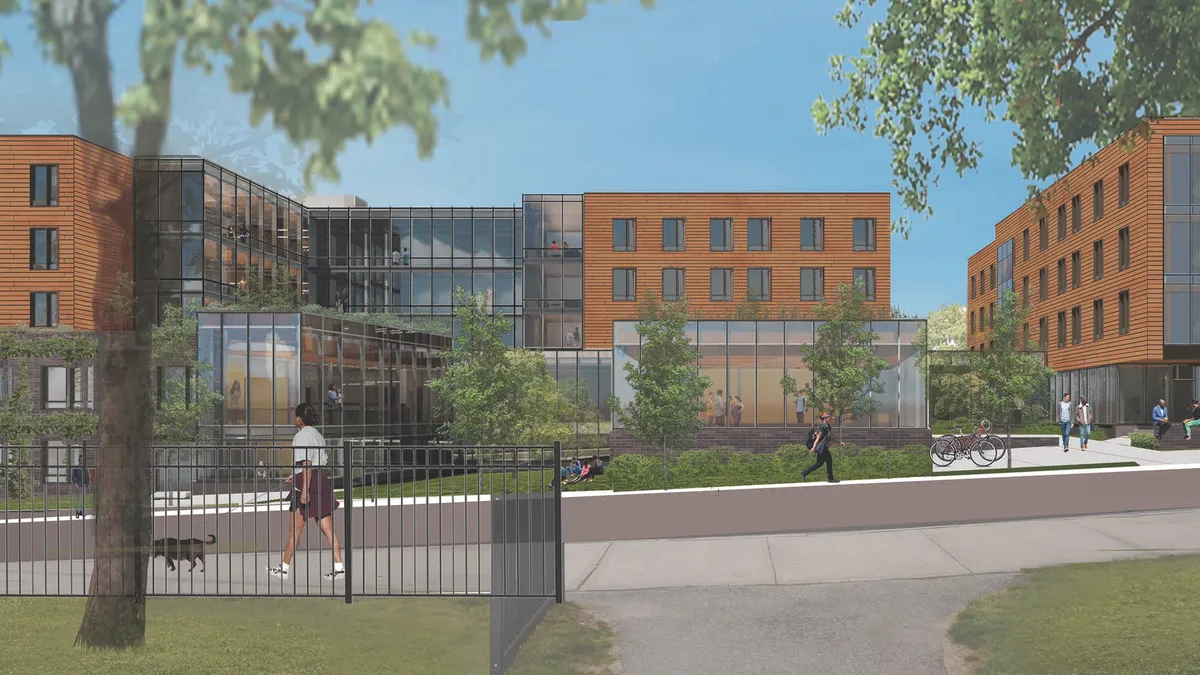For the first time in 30 years, Brown University commissioned a new student housing building for its Providence, Rhode Island, campus. To help meet the university's goal of being carbon neutral by 2040, the project team, including Shawmut Design and Construction and William Rawn Architects, selected cross-laminated timber (CLT), which also helped to save time and increase flexibility around scheduling.
The product was one factor in helping this design-build project finish on schedule, even despite the outbreak of the COVID-19 pandemic early in construction, according to Ron Simoneau, Shawmut executive vice president of education. The building program features a 162-bed residence hall situated above first-floor services aimed at improving student physical, mental and emotional wellbeing.
“We collaborated with William Rawn to develop a design-build approach, which you often don’t see with higher education clients,” Simoneau said. “This alternative delivery system lets us get more creative in problem-solving, ring out waste and maximize value holistically.”
Benefits: time savings and sustainability
CLT is created by a process of finger joining dimensional lumber to a specific length and gluing layers together perpendicularly. The layers — typically three, five, or seven — get compressed to create consistent, strong planks. These structural components can be ordered in sizes as big as whatever will fit onto a trailer. The Brown U. building incorporates a hybrid system of CLT and steel.
“We used a steel structure with CLT planking as the floor/ceiling system,” Simoneau said. “The hybrid approach saves a lot of time in several ways. CLT decking goes up at the same time as the steel, for example, so crews don’t have to wait for platform concrete to dry and can start working immediately after installation.”
This also means safer working conditions because the floors are finished before anyone begins cutting holes for pipes, ductwork or electrical runs. Simoneau said another perk is that CLT offers shorter lead times than many prefabricated structural materials, such as precast concrete plank. CLT is also flexible and easy to work with on-site.
“CLT is a premium, ultra-sustainable product with a higher cost than concrete or steel, but when you net it out with savings on scheduling and finishes, it becomes a wash,” he said. “It just goes up so fast.”
In this project, the CLT is being used for all floors and the roof assembly. The material will be left exposed for wood ceilings, which offers even more cost- and time-savings by eliminating drywall and painting. The warmth of exposed wood — along with the lack of any off-gassing — also enhances the building’s sense of wellness.
Challenges: unfamiliarity with material and installation
There were some challenges associated with the material, Simoneau said.
“CLT is a relatively new material in the U.S., so there’s not a huge workforce trained in installing or working with it. And there are nuances around fireproofing — although it has an inherent rating as used in assembly — all building structure must be connected to steel," he said.
Simoneau said tracking materials, including the CLT that came from Nordic Structure in Canada, generated one of the biggest hurdles to staying on schedule. Brown U. plans to make student housing less dense and was motivated to keep this building moving toward the fall 2021 open date as many rooms were already dedicated to single occupancy.
“One of the biggest challenges was COVID’s impact on supply chain with factories shut down,” he said. “We already tracked products carefully, but with COVID, it's now a new level of tracking parts that go together to prevent delays."
Construction never stopped on the project as COVID-19 spread across the country and Shawmut used the site to find ways of keeping crews healthy. According to officials, the project helped the firm figure out safety protocols, such as personal protective equipment, daily temperature taking and testing for Shawmut Vitals, the company’s self-screening app.
The jobsite — like all Shawmut sites — is staffed with a COVID-19 officer who enforces safety rules. The company also created a command center to help guide COVID-19 protocols and ensure they follow all federal, state, local and CDC recommendations.
“The project started before COVID hit and Rhode Island never shut down construction, so we continued to work through it,” Simoneau said. “When it hit, we were all still working outside and able to adapt with the learning curve. We maintained distancing easily and as we learned more, we worked with different organizations to keep up with standards.”





















